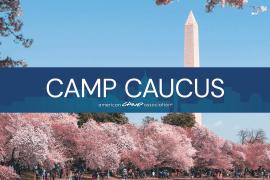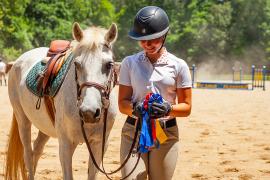In our last Research 360 blog post, I shared some of the key findings from Phase 2 of ACA’s Youth Impact Study. Here is a quick summary:
Camp makes a difference!
Well, there is a little more to it than that, namely that camp experiences appear to help young people learn valuable skills that they use later in life, especially in places like college and first-time jobs. Outcomes such as responsibility, independence, appreciation for others’ differences, and appreciation for living in the moment are among those we are calling distinct and transferable: distinct because participants are reporting these are things they learned at camp that they did not learn as much in other contexts, like school or youth sports, and transferable because participants rated these outcomes as the most important in their lives today.
These are exciting findings, but they are only valuable when they are used to improve programs, increase enrollment, and to advocate for camp to parents, funders, and potential partners. So, in this post, I suggest ten ways you can use what we learned in Phase 2 of the Impact Study at your camp.
1. Use the language of distinct and transferable in your marketing materials.
Some examples: Research tells us that camp experiences are distinct from other learning environments because kids learn skills at camp that they do not learn in the same way in school, or Research suggests that the skills campers learn at camp last far beyond their camp experience, and specifically help them in school, when they attend college, and in their first jobs.
2. Make responsibility, appreciation for differences, relationship skills, and appreciation for living in the moment visible.
Our findings so far point to these outcomes, among others, as the most distinct to camp and the most valuable later in life, according Impact Study participants. In fact, these outcomes appear strongly across a variety of camp types and participant samples, so it is very likely that your campers are experiencing these outcomes at your camp. Make them visible by intentionally designing activities, naming it when you see it, and helping campers reflect on these outcomes during discussion time.
3. Measure responsibility, independence, teamwork, affinity for nature, and friendship skills.
Measuring camper outcomes is a powerful way to document and communicate the value of your program, as well as a great tool for monitoring whether your staff and programs are doing what you want them to do. Check out ACA’s Youth Outcomes Battery — we have surveys designed specifically for use at camp to measure each of these outcomes, either just one or a combination of them.
4. Engage your staff in making sense of these findings for your camp.
The Impact Study is designed to represent the camp experience at a very broad level, which is why we’ve included camps of all shapes and sizes in the study. But this means that our findings might apply to your camp in unique or subtly different ways — use these findings as the basis of conversation with your staff, asking what does this mean for us? And how can we use this to improve our outreach and our programs?
5. Claim your place as an important part of the learning landscape.
We know that kids learn all of the time and in every context in which they are a part — school, home, sports, community groups, to name a few. The Impact Study findings tell us that camp experiences foster social-emotional learning, and models of social-emotional learning connect the types of social emotional learning that happens at camp with thriving in college, career, and in adulthood. Use these findings to connect with schools, or to demonstrate to parents why camp experiences support school learning in lasting ways.
6. Put your people front and center.
In Phases 1 and 2 of the Impact Study, we asked former campers what happened at camp that helped them learn the skills they consider most important now in their emerging adult lives. The strongest response? People. The people at camp — which includes staff and peers — are what we call a critical mechanism for lasting learning. Caring staff who have meaningful interactions with campers, small group activities, and, in some cases, living/cabin arrangements, and opportunities to get to know kids from different places and with different backgrounds are among the ways camp relationships are among the most powerful sources of learning at camp. Celebrate that in your staff training and when you advocate to camp to parents, funders, and other potential partners.
7. Build loyalty to camp.
We found that people who attended camp as a kid who are now working at an ACA-accredited camp learned similar skills as people who attended camp but are not working at an ACA-accredited camp; however, the former campers in the first group report higher levels of these skills than the second group. This makes perfect sense — the people that are still seeking out camp experiences attribute more of their overall learning to camp (compared to school and other contexts). Not only is this a great foundation for fostering future camp leaders, but also an opportunity to showcase the value in sustained camp experiences.
8. Remind staff that they are in the business of changing the world.
We learned in a survey of returning staff members that one of the main reasons they keep coming back to camp is because they want to feel like they are making a difference in kids’ lives. This is common among today’s emerging adult working population, so feature this in your staff recruitment efforts. Once your staff are at camp, give them opportunities during the summer to write down how they feel when they are working at camp, and capture testimonials from them about their sense of making a difference.
9. Honor the opportunity to disconnect.
One of the more surprising findings that has emerged so far is that former campers report that they learned an appreciation for living in the moment during their time at camp. While this is a concept we will continue to explore, we know that it represents one of the most unique things a person can learn at camp and something that is critical today. Consider ways to use the fact that many camps, even day camps, are in a separate time and place than a camper’s home environment, as an opportunity for learning during activities and reflection time. Nature-based camps, this is a great opportunity to celebrate the ways you connect kids to the outdoors and help them identify how that makes them feel.
10. Celebrate research!
One of the best ways you can use this research is to demonstrate to parents, staff, funders, potential partners, and other stakeholders that camp experiences last over time, and we have scientific evidence to show for it. Celebrate that you are part of a community that values its work and actively seeks evidence not only to showcase the great ways kids and staff learn at camp, but also for continuous program improvement. Share our Research 360 blogs and the Camp Impact Study web page, which includes a great series of videos featuring former campers in their jobs today, in your marketing materials, on social media, and with your staff!
That’s all for now, but there is much more to come on the Camp Impact Study and how you can use what we are learning at your camp. Next up: findings from a survey of returning staff and things we are learning about camp from parents. In the meantime, keep up your important camp work, and all the best during this holiday season.
Laurie Browne, PhD, is the director of research at ACA. She specializes in ACA's Youth Outcomes Battery and supporting camps in their research and evaluation efforts. Prior to joining ACA, Laurie was an assistant professor in the Department of Recreation, Hospitality, and Parks Management at California State University-Chico. Laurie received her Ph.D. from the University of Utah, where she studied youth development and research methods.
Photo courtesy of Camp Woodhaven in West Boylston, Massachusetts
Thanks to our research partner, Redwoods.
Additional thanks goes to our research supporter, Chaco.
The views and opinions expressed by contributors are their own and do not necessarily reflect the views of the American Camp Association or ACA employees.




